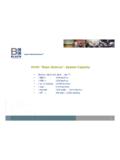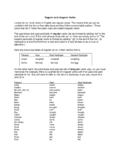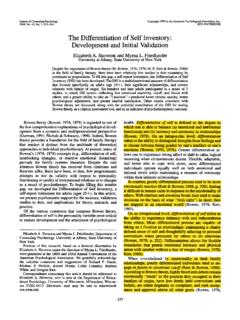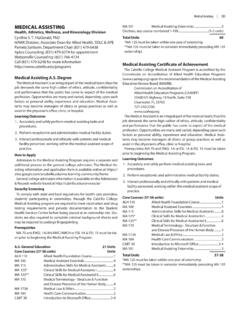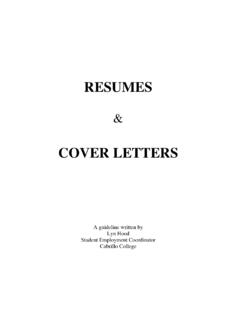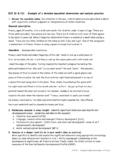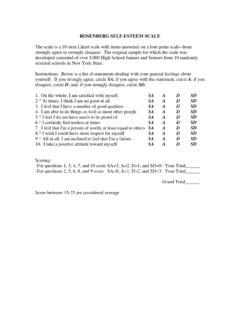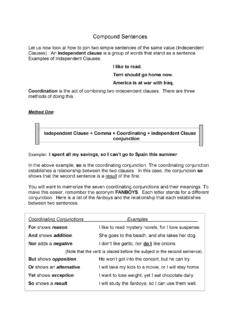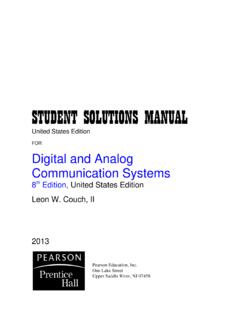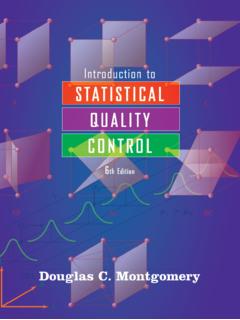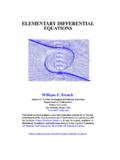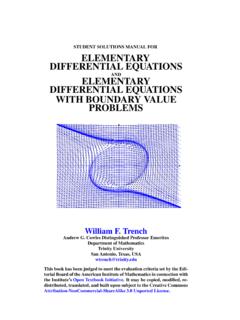Transcription of CHAPTER 3: PROBABILITY TOPICS - Cabrillo College
1 CHAPTER 3: PROBABILITY TOPICS Exercise 1. In a particular College class, there are male and female students . Some students have long hair and some students have short hair. Write the symbols for the probabilities of the events for parts a through j. (Note that you cannot find numerical answers here. You were not given enough information to find any PROBABILITY values yet; concentrate on understanding the symbols.) Let F be the event that a student is female. Let M be the event that a student is male. Let S be the event that a student has short hair. Let L be the event that a student has long hair.
2 A. The PROBABILITY that a student does not have long hair. b. The PROBABILITY that a student is male or has short hair. c. The PROBABILITY that a student is a female and has long hair. d. The PROBABILITY that a student is male, given that the student has long hair. e. The PROBABILITY that a student has long hair, given that the student is male. f. Of all the female students , the PROBABILITY that a student has short hair. g. Of all students with long hair, the PROBABILITY that a student is female. h. The PROBABILITY that a student is female or has long hair. i. The PROBABILITY that a randomly selected student is a male student with short hair.
3 J. The PROBABILITY that a student is female. Solution a. P(L )=P(S) b. P(M OR S) c. P(F AND L) d. P(M|L) e. P(L|M) f. P(S|F) g. P(F|L) h. P(F OR L) i. P(M AND S) j. P(F) Exercise 2. A box is filled with several party favors. It contains 12 hats, 15 noisemakers, ten finger traps, and five bags of confetti. Let H = the event of getting a hat. Let N = the event of getting a noisemaker. Let F = the event of getting a finger trap. Let C = the event of getting a bag of confetti. Find P(H). Solution = Exercise 3. A box is filled with several party favors. It contains 12 hats, 15 noisemakers, ten finger traps, and five bags of confetti.
4 Let H = the event of getting a hat. Let N = the event of getting a noisemaker. Let F = the event of getting a finger trap. Let C = the event of getting a bag of confetti. Find P(N). Solution P(N) = = Exercise 4. A box is filled with several party favors. It contains 12 hats, 15 noisemakers, ten finger traps, and five bags of confetti. Let H = the event of getting a hat. Let N = the event of getting a noisemaker. Let F = the event of getting a finger trap. Let C = the event of getting a bag of confetti. Find P(F). Solution P(F) = = Exercise 5. A box is filled with several party favors. It contains 12 hats, 15 noisemakers, ten finger traps, and five bags of confetti.
5 Let H = the event of getting a hat. Let N = the event of getting a noisemaker. Let F = the event of getting a finger trap. Let C = the event of getting a bag of confetti. Find P(C). Solution P(C) = Exercise 6. A jar of 150 jelly beans contains 22 red jelly beans, 38 yellow, 20 green, 28 purple, 26 blue, and the rest are orange. Let B = the event of getting a blue jelly bean Let G = the event of getting a green jelly bean. Let O = the event of getting an orange jelly bean. Let P = the event of getting a purple jelly bean. Let R = the event of getting a red jelly bean. Let Y = the event of getting a yellow jelly bean.
6 Find P(B). Solution P(B) = = Exercise 7. A jar of 150 jelly beans contains 22 red jelly beans, 38 yellow, 20 green, 28 purple, 26 blue, and the rest are orange. Let B = the event of getting a blue jelly bean Let G = the event of getting a green jelly bean. Let O = the event of getting an orange jelly bean. Let P = the event of getting a purple jelly bean. Let R = the event of getting a red jelly bean. Let Y = the event of getting a yellow jelly bean. Find P(G). Solution P(G) = = Exercise 8. A jar of 150 jelly beans contains 22 red jelly beans, 38 yellow, 20 green, 28 purple, 26 blue, and the rest are orange.
7 Let B = the event of getting a blue jelly bean Let G = the event of getting a green jelly bean. Let O = the event of getting an orange jelly bean. Let P = the event of getting a purple jelly bean. Let R = the event of getting a red jelly bean. Let Y = the event of getting a yellow jelly bean. Find P(P). Solution P(P) = = Exercise 9. A jar of 150 jelly beans contains 22 red jelly beans, 38 yellow, 20 green, 28 purple, 26 blue, and the rest are orange. Let B = the event of getting a blue jelly bean Let G = the event of getting a green jelly bean. Let O = the event of getting an orange jelly bean. Let P = the event of getting a purple jelly bean.
8 Let R = the event of getting a red jelly bean. Let Y = the event of getting a yellow jelly bean. Find P(R). Solution P(R) = = Exercise 10. A jar of 150 jelly beans contains 22 red jelly beans, 38 yellow, 20 green, 28 purple, 26 blue, and the rest are orange. Let B = the event of getting a blue jelly bean Let G = the event of getting a green jelly bean. Let O = the event of getting an orange jelly bean. Let P = the event of getting a purple jelly bean. Let R = the event of getting a red jelly bean. Let Y = the event of getting a yellow jelly bean. Find P(Y). Solution P(Y) = = Exercise 11. A jar of 150 jelly beans contains 22 red jelly beans, 38 yellow, 20 green, 28 purple, 26 blue, and the rest are orange.
9 Let B = the event of getting a blue jelly bean Let G = the event of getting a green jelly bean. Let O = the event of getting an orange jelly bean. Let P = the event of getting a purple jelly bean. Let R = the event of getting a red jelly bean. Let Y = the event of getting a yellow jelly bean. Find P(O). Solution P(O) =150 22 38 20 28 = = = Exercise 12. There are 23 countries in North America, 12 countries in South America, 47 countries in Europe, 44 countries in Asia, 54 countries in Africa, and 14 in Oceania (Pacific Ocean region). Let A = the event that a country is in Asia. Let E = the event that a country is in Europe.
10 Let F = the event that a country is in Africa. Let N = the event that a country is in North America. Let O = the event that a country is in Oceania. Let S = the event that a country is in South America. Find P(A). Solution P(A) = = Exercise 13. There are 23 countries in North America, 12 countries in South America, 47 countries in Europe, 44 countries in Asia, 54 countries in Africa, and 14 in Oceania (Pacific Ocean region). Let A = the event that a country is in Asia. Let E = the event that a country is in Europe. Let F = the event that a country is in Africa. Let N = the event that a country is in North America.
